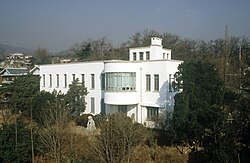|
Kansong Art Museum
The Kansong Art Museum (Korean: 간송미술관) is located in Seongbuk-dong, Seongbuk District, Seoul, South Korea. The predecessor to the museum, Bohwagak (보화각; 葆華閣), was founded by Jeon Hyeong-pil in 1938.[1] It was the first privately-owned museum in Korea, and showcased various Korean historical and artistic materials that Jeon had gathered.[1] His goal was to prevent Japanese removal of Korean cultural properties during the Japanese colonial period.[2] Numerous Korean cultural properties were taken to Japan, such as Goryeo porcelains, Silla-era Buddhist statues, and Joseon-era texts.[3] The museum was designed by architect Park Gil-ryong (박길룡).[1] Jeon died in 1962; his sons Jeon Seong-u (전성우; 全晟雨) and Jeon Yeong-u (전영우; 全暎雨) continued his work in museum and art curation. In 1966, the Kansong Art Museum and the Korean Folk Art Research Institute (한국민족미술연구소; 韓國民族美術硏究所) were founded by the pair. The former entity shows pieces to the public, and the latter performs academic research.[1] The museum is named for the art name of Jeon Hyeong-pil (간송; 澗松; Kansong). As of 2011[update], the museum housed twelve national treasures. This includes a copy of the Hunminjeongeum, which first described the Korean script Hangul[1] (National Treasure No. 70). Other national treasures include Donggukjeongun Book 1, 2 (National Treasure No. 71), Geumdong gyemimyeong samjonbul (No. 72 National Treasure), and Hyewon pungsokdo.[citation needed] GalleryWikimedia Commons has media related to Gansong Art Museum.
See alsoReferences
External links |
||||||||||||||||||||||||||








